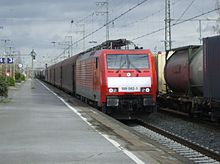Swing entry
A swing entry is the entry of an electric traction vehicle, dependent on the contact wire , into a station area without a suitable power supply. The locomotive runs without its own drive.
Border stations

At border stations , which are also the interface between different traction current systems , there are two fundamentally different operating concepts. On the one hand, there are switchable overhead line sections, and on the other, the concept of entry with momentum. The latter is used, for example, in the Venlo train station (only in the freight yard) or in the Brenner train station . The dividing point between the traction current systems is roughly in the middle of the station. Incoming trains drive into the station, ironed, and roll without electricity under the external electricity system. By a switch engine is electric locomotive later pushed back under the right traction power system.
Freight trains in transshipment stations
The swing entry as a concept for the entry of block trains from container wagons guided by electric locomotives into the transshipment station replaces shunting trips .
The track section under the existing gantry crane cannot be spanned with a contact wire. This is why the freight train's electric locomotive drives under the crane's working area by swinging entry. The kinetic energy of the train is sufficient to guide the electric locomotive to the next electricity-carrying section beyond the gantry crane and thus to the exit position.
So far, diesel locomotives have been used to provide the freight train and to enable loading and unloading. Once the contact wire interrupted above the loading track has been set up and the operating concept for the swing entry has been approved, block trains pulled by electric locomotives can enter under the loading crane "in one swing". This saves shunting trips.
The swing entry is used, for example, in Munich-Riem, Kornwestheim and Ludwigshafen as well as at the port terminals of HHLA and Eurogate . From 2019, the then completed Lehrte megahub will be operated with a swing entrance.
Special case of the old Berlin Central Station
In what was then Berlin Central Station (today Berlin Ostbahnhof ), the apron of the platform hall was too low for the contact wire. During the GDR era, the contact wire ended on the east side of the hall, and the tram leading to West Berlin on the west side remained in diesel mode anyway.
Arriving electrically powered trains drove into the hall with momentum and were shunted with diesel locomotives. Departing trains were made available in such a way that the electric locomotive stayed in front of the hall.
When the tram was electrified, the hall aprons were removed until 1998; today, continuous electrical operation is possible.
Individual evidence
- ↑ ( Page no longer available , search in web archives: Bahn TV )
- ↑ Commissioning on or in the 2019 network timetable ( memento from October 5, 2017 in the Internet Archive ), on dbnetze.de, accessed on October 4, 2017 (pdf, 76 kB)
Web links
- Container Terminal Salzburg is being expanded by 40 percent , in the Österreich-Journal on June 19, 2006